Humpback Whale Watching In Maui
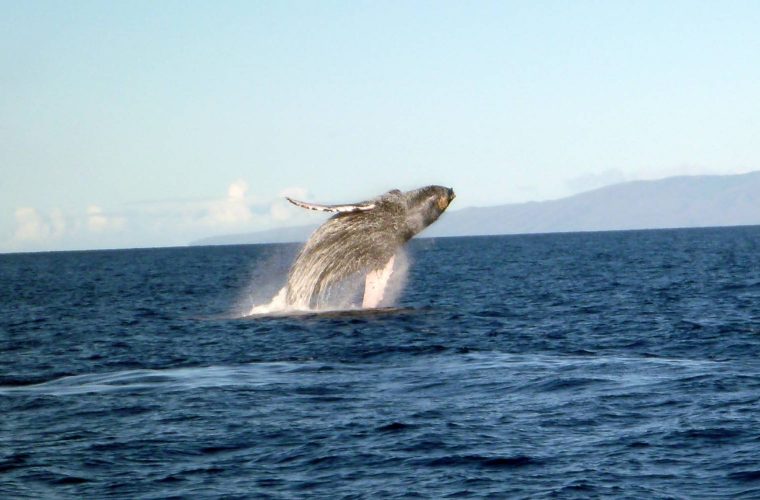
Traveling to Maui is a bucket list item for people all over the world. There are many reasons why so many people want to travel to the beautiful island of Maui. One of our favorite things about Maui is WHALE SEASON! What is the “Best Whale Watching Tour in Maui” you ask? The Four Winds and the Maui Magic! Not only do you get the chance to snorkel, but all of our trips include an added bonus of whale watching during whale season. The Four Winds II is our family fun boat and is great for all ages and levels of swimmers. If you are looking for something a bit more personable with smaller groups, check out the Maui Magic snorkel and whale watch combo!
People from all over the globe come to see the whales in their natural habitat. Before you start planning your next Maui vacation during whale season, we have all the answers to your questions!
What Are the Best Months to Whale Watch in Maui?
The best months are typically November to January (and early February). Whale Season typically starts in mid December and goes until the whales start to migrate back to Alaskan waters. Late April and into May is when it is typically considered to be the end of whale season.
What Time of Day is Best for Whale Watching?
The best time is ANYTIME! If you are wanting to try and snorkel Molokini Crater, your best chance of going to Molokini and whale watching would be during the early morning. The trade winds tend to be calmer during the morning trips. The Four Winds II afternoon snorkel and whale watching tour usually goes to Coral Gardens, but you will still whale watch and snorkel and is the perfect trip for those who are late risers.
How Long Does it Take the Whales to Swim from Alaska to Hawaii?
For an average humpback whale, it takes approximately six weeks for them to swim between Alaska and Maui. While the whales are traveling, they take small naps that usually last around 30 minutes and still remain in constant motion. Amazing!
What Side of the Island of Maui is Best for Whale Watching?
While there are a lot of beautiful places to stay on Maui, the south and west sides of the island provides the best location for whale watching. Most whale watching tours leave out of Maalaea Harbor and Lahaina Harbor. If you are wanting to whale watch AND go to Molokini, you will most likely be leaving out of Maalaea Harbor.
Most people choose to stay in Wailea or Kihei for trips leaving out of Maalaea Harbor. If you choose to take a tour out of the Lahaina Harbor, most of the hotel options are in Kaanapali and Lahaina. If you have the option of booking a hotel that has an ocean view, BOOK IT! You will love being able to sit out on your ocean view balcony and getting to see the incredible humpback whale breaches! It doesn’t hurt to bring a pair on binoculars so you can get a closer look!
Are Whales in Maui NOW?
The answer is, YES! The first whale of the season was spotted on October 9th, 2019! The Maui Magic spotted its first whales on Halloween, October 31st, 2019. As we head into December, we will most-likely see a large influx of whale sightings, as the whales tend to be more prevalent in December through March.
What Makes the Best Whale Watching Tour on Maui?
The list of tour companies is long when you are looking at Whale Watching in Maui. How do you know which tour is the best fit for you?
The Four Winds II Maui
Whether you are an experienced snorkeler or do not know how to swim, the Four Winds has you covered. Our crew is the best and they will assist you with any questions you have. You’ll enjoy: quality snorkel gear, flotation (including our very own Sea Boards), delicious food options, glass bottom viewing room, listening to the whales through our hydrophone, knowledgeable and experienced captains that LOVE spotting whales just as much as you do!
The Maui Magic
Are you a couple looking for a smaller and more personable experience? Or do you love adventure? Then you will love the Maui Magic! The Magic will take you to the best snorkel spots Maui has to offer. The Maui Magic offers quality food options, top notch snorkel gear, a hydrophone, experienced and knowledgeable captain and crew, and access to two snorkel sites. This tour is faster paced than the Four Winds and is not recommended for ages under 5.
If you can’t wait to meet the whales in Maui from up close, get in touch with us to learn more about our tours!
Humpback Whale Season on Maui
Every winter, when storms sweep through the North Pacific and the ocean gets particularly chilly, humpback whales head south—specifically to the warm waters of Hawaii’s Au’Au Channel alongside Maui. And if you’re hoping to catch a glimpse of these graceful behemoths, January through mid-March is the best time of year to see them!
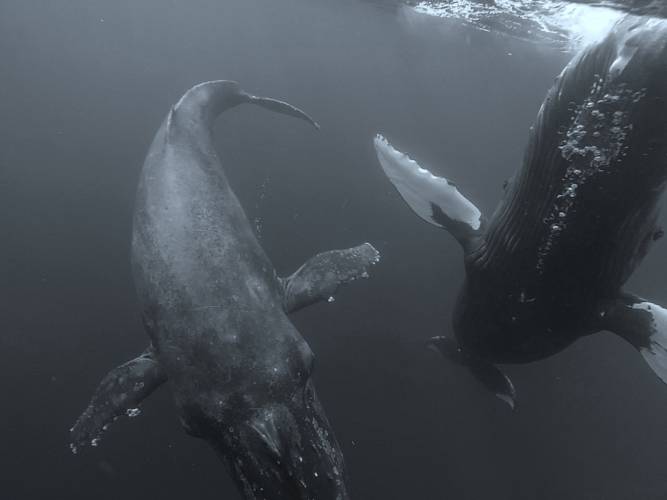 There are a number of great certainties in life; the sun will set each night, Old Faithful will continue to blow, the humpback whales will return to Maui every year And people will go to see them! As cliché as it sounds, it’s absolutely true. Year after year, thousands of whales frequent the Hawaiian Islands to mate and give birth in the warm tropical waters. There’s something so amazing and majestic about watching a 40 ft long, 40 ton whale as it launches itself out of the water, putting on an aerial show for tens of thousands of onlookers every year.
There are a number of great certainties in life; the sun will set each night, Old Faithful will continue to blow, the humpback whales will return to Maui every year And people will go to see them! As cliché as it sounds, it’s absolutely true. Year after year, thousands of whales frequent the Hawaiian Islands to mate and give birth in the warm tropical waters. There’s something so amazing and majestic about watching a 40 ft long, 40 ton whale as it launches itself out of the water, putting on an aerial show for tens of thousands of onlookers every year.
The waters of Maui have long been the favored vacation spot of these massive marine mammals. During Whale season,we are one of the few companies that combine a snorkeling excursion with the exciting experience of viewing whales! enjoy all the fun of a snorkeling trip with the awe- inspiring show of the humpback whales! Our crew grills up the best burgers and chicken on Maui and serves you your choice of beverages while you spend a lazy afternoon snorkeling and enjoying the water slide!Viewing these majestic creatures from our whale watching boats is one of the most exciting things you will ever do! While on board,our Marine Naturalists and knowledgeable crew will enlighten and educate you about these wonderful creatures.
Every year from December through March the North Pacific Humpback Whales migrate to the warm tropical waters of Hawaii. The coastal waters of Maui by far, enjoys the largest concentration of these amazing animals and is some of the best in the world ,and as good as it gets! .
Sightings of these playful creatures, which grow as large as 50 feet and weigh about one ton per foot, on our afternoon snorkeling trip are quite regular!
Witness a mother whale frolic with her calf, or a full-grown adult breach out of the water. During your whale watch cruise these amazing animals will often display themselves in full glory, giving you the ultimate whale watching on Maui experience.
Some common behavior displayed on a whale watching trip includes blowing and spy hopping. They’ll also slap their tails, believed to be an act of communication and to demonstrate their individual strength. Spy hopping is when the humpback whales come high out of the water to literally have a look around at the world above.
A mature North Pacific Humpback Whale averages about 40ft in length & weighs about 40 tons, although can grow up to 16 meters or 52ft long. Their heavy bodies can weigh up to 50 tons. The heart alone is about 400lbs or more. The size of these whales makes them hard to miss, especially when they swim in groups. Female whales are slightly larger, in order to defend themselves and their nursing calves from the more aggressive males.
It is common during the Maui whale watching season to find large competitive groups (pods) of male humpback whales jousting for the opportunity to mate with a single female. Watching them is an exciting experience, as they wrestle with each other for the position to mate.
The female humpback whales with new born calves are particularly vulnerable to the advances of the males during the Maui whale watching season. Sometimes during our whale watch we are mugged (an affectionate term), by the female and her calf as she uses our large yacht to hide under in an attempt to ditch the hopeful males. Other times curiosity causes them to come closer to us. It’s the ultimate whale watching experience where photo opportunities create cherished memories. Join us for the best Maui whale watching for the memories of a lifetime! The North Pacific Humpback Whale is a baleen whale (toothless), declared as an endangered and protected species.
Humpback whales migrate in the thousands from the Gulf of Alaska to and around the Hawaiian Islands, and in particular the island of Maui, creating the perfect Maui whale watching experience. The island of Maui offers sheltered water, where the females can more safely give birth and raise their young.
Whales are mammals and the calves are fed with their mother’s milk. While suckling, it is believed they may be safer from predators in the sheltered Maui waters, as opposed to the open ocean or less protected seas.
Whale watching in Maui is as good as it gets, with the opportunity on any given trip to see numerous animals displaying a variety of interesting and memorable behaviors.
Newborn calves in addition to being adorable are curious and often bring mom close to the boat for a close encounter. As a protected animal, it is unlawful to approach closer than 100 yards from these majestic animals during a Maui whale watch, and we adhere strictly to these regulations.
It is not uncommon for the whales to approach us as we sit idle in the water. Close encounters initiated by the whales are common on a whale watching tour in Maui.During the Maui whale watching tour, you might see a young calf swimming beside its mother. The newborn calves are about 14 feet long. When you see them, you have definitely experienced some of the best whale watching. They are not small, even when newborn.The mother stays with her offspring for about one year, feeding it with up to 100 gallons of milk every day. Life span has been discussed and not agreed upon by most researchers. No one knows how long humpbacks live, but bowhead whales (a cousin) have been proven to live well beyond 200 years!
To make your whale watch cruise in Maui even better, we’re going to take you on a snorkel adventure where you will enjoy snorkeling at one of Maui’s beautiful coral reefs. Whale Watching and snorkeling on the same cruise is the perfect pairing of the two most popular ocean adventures on Maui.
We look forward to seeing you soon!
Humpback Whale Behaviors To Look For
December through March on Maui is purely magical. Whale season is one of the best times of the year to visit Maui. Experience the Humpback Whales and view them in their natural habitat. During their annual migration to Maui’s coastal waters, they come to calve, mate, and rear their young.
With the large pods of Humpback Whales concentrated in the Maui waters, you can see them up close for yourself! Brace yourself and expect to have some amazing encounters with these beautiful creatures. See the whales in action performing aerobatics, breaches, tail slaps, spy hopping, and more!
HUMPBACK WHALE BEHAVIORS
Spy Hop: When a whale rises with just its head sticking up out of the water. It is believed that they do this to look around and see what is happening around them.
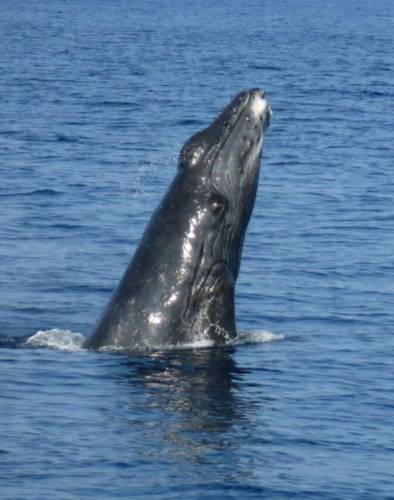
Blow: Blowholes are like a whales nostrils and are located on top of their heads. The blowhole expels air as a cloud of condensation. This condensation helps us spot and find whales on the open ocean.
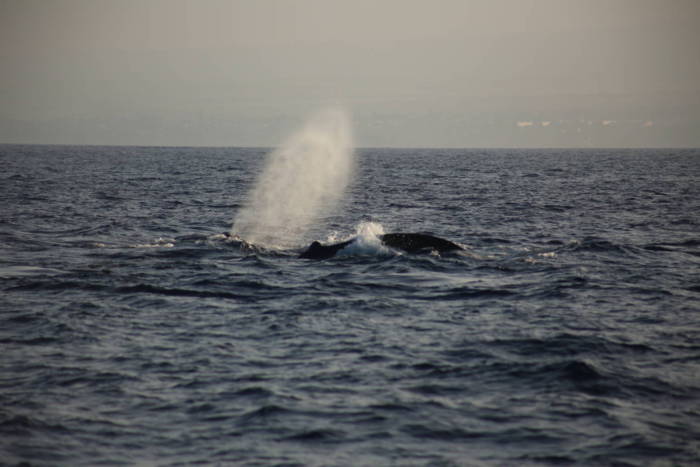
Pec Slap (Pectoral Slapping): Humpback whales will slap the surface of the water with one or both of their fins, over and over, to communicate with other whales.
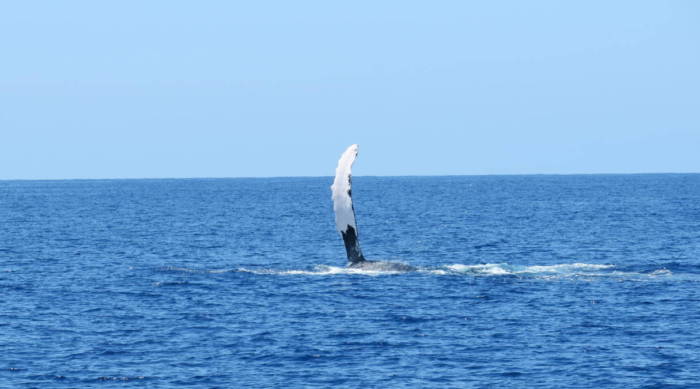
Tail Slapping: Humpbacks raise their tail out of the water and slap the surface of the water with great force. Tail slapping is believed to be a form of communication with other whales nearby.
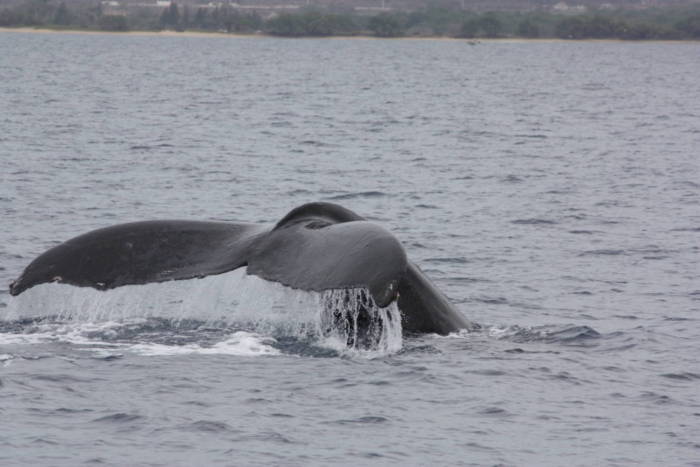
Peduncle Throw (Tail Throw): A whale throws its tail out of the water energetically and slaps its peduncle (rear part of its torso) onto the water.
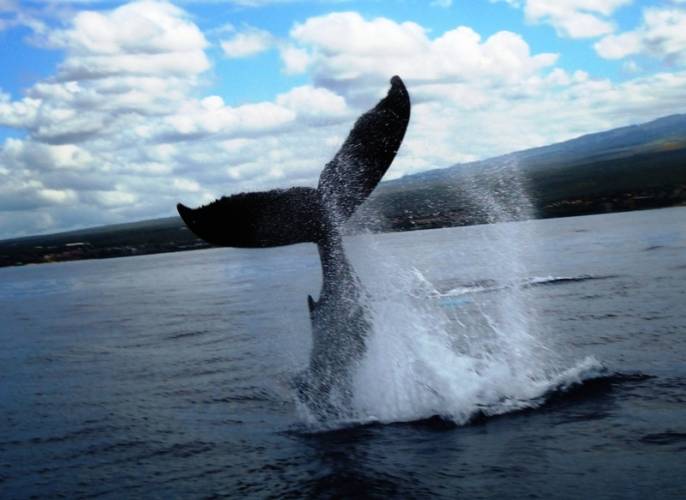
Breach: Breaching is the most exciting whale behaviors to witness. In this circumstance, the whale jumps clear out of the water by using its tail. The massive splash it creates is quite a sight!
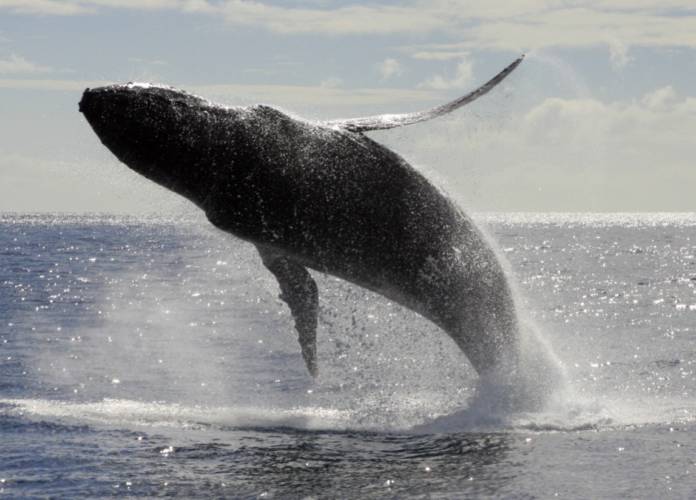
Whales History
Whale season on Maui is a fantastic time of year. Normally, we start to see whales migrate to the Hawaiian waters around late November – early December.
Approximately 12,000 humpback whales make their way towards Hawaii every year, and possibly even more! The trip from Alaska to Hawaii is approximately 3,000 miles each way. Humpback whales usually swim at a pace of 3-5 mph and it can take the whales approximately 6-8 weeks to reach their destination. The whales travel from Alaska where they feed and then arrive to Hawaii to mate, rear their young, and to give birth. At birth, they weigh an average of 1.5 tons and are usually 10-16 ft. in length. They grow very fast and nearly double their length during their first year. Baby humpbacks nurse for nearly 6 months on their mother’s milk (consisting of about 50% fat), drinking as much as 600 liters of milk per day to help prepare them for the trip towards colder waters. The lifespan of a whale is said to average around 50 years. The number of humpbacks in Hawaiian waters is increasing significantly every year. Up until 1986, they were hunted into near extinction, with the count thought to be less than 1,500. In 1986, the International Whaling Commission introduced a ban on commercial humpback whaling.
One of the reasons Maui is so popular is due to its radiant beauty. You can choose to snorkel, surf, stand up paddle board, watch sunrise and/or sunset on top of a 10,000 foot volcano, whale watching, drive the Road to Hana, snorkel Molokini crater, or just relax on the beach. Maui has a ton to offer! Some of the best whale watching in the world is located on our beautiful island of Maui. The waters surrounding Maui become a whales playground every winter. Maui has a front seat in witnessing these magnificent creatures, due to the shallow waters within the Auau Channel (located between Maui, Molokai and Lanai).
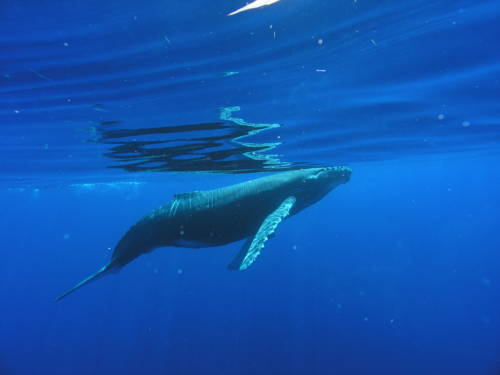 One of the great things about taking a Molokini snorkeling tour on the Four Winds II or the Maui Magic during whale season, is you will be able to check more than one item off your list, or what we like to call, a “twofer”. Enjoy the best snorkeling in Maui and snorkel Molokini and experience the Four Winds II glass bottom. You will get the chance to see some of the best whale watching on the way to your snorkel destination.
One of the great things about taking a Molokini snorkeling tour on the Four Winds II or the Maui Magic during whale season, is you will be able to check more than one item off your list, or what we like to call, a “twofer”. Enjoy the best snorkeling in Maui and snorkel Molokini and experience the Four Winds II glass bottom. You will get the chance to see some of the best whale watching on the way to your snorkel destination.
History on Whaling and Hawaii
Not only was Lahaina the capital of the Kingdom of Hawaii from 1820 to 1845, but it was also the center of whaling in Hawaii. In 1845, the capital moved to Honolulu. During 1820 to 1845, Lahaina was known as the the Pacific’s top whaling port. Whaling ships (responsible for hunting the sperm whales for whalebone, but mainly for the oil from the whale blubber) anchored in Honolulu and Lahaina. The impact of whaling vessels within Hawaii shaped the Hawaiian economy and was the primary source of income for the islands until about 1854. Whalers were hunting thousands of whales each year and was headed towards extinction. Luckily today we have laws that protect the whales, which has helped increase the population in Hawaii.
When Do We Normally See the Humpback Whales in Maui?
From December through March, you can join us on our daily Maui snorkeling tours to see the spectacular Humpback Whales. Experience the Humpback Whales in their natural habitat during their annual migration to Maui’s coastal waters as they come here to calve & mate. Whale watching is a part of both our Morning Molokini Snorkel Tours and the Afternoon Snorkel to Coral Gardens tour.
The island of Maui is the second largest island in the Hawaiian Island chain and is approximately 727 square miles. Maui is the 17th largest island in the United States. Technically, the County of Maui also includes Kahoʻolawe, Molokaʻi, and Lānaʻi.
Did you know that the Humpback Whales don’t eat while they are in Maui ? They live off their body fat while they are here. The whales hunt and feed during the summer months in the cold Alaskan waters before migrating toward Hawaii to give birth and mate. We just don’t have the food supply they need here!
Humpback Whales often travel alone or in a small groups. In most cases, a pod may consist of a mother whale, her baby, and an escort whale. The escort is male whale, not necessarily the father of the calf, that joins the mother to help protect the young calf while migrating.
A female whale can bear offspring once every 2-3 years and average duration of gestations for the calf is 12 months. Even if not carrying a calf , some females will still make the annual trip from Alaska to Maui.
Whale Behavior
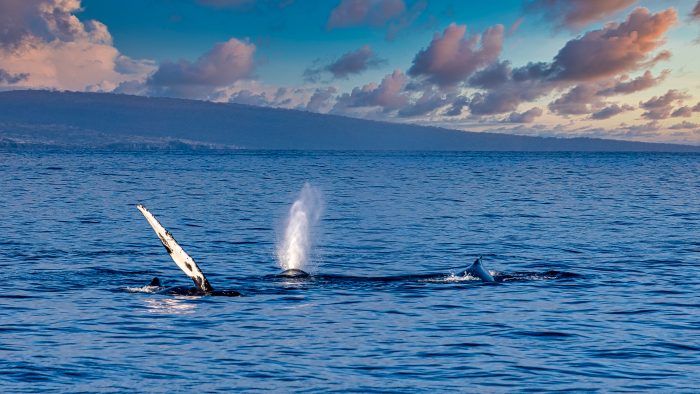 For a humpbacks, the purpose for this exciting display of power is not completely understood, but there are some interesting suggestions. Young whales likely breach as a form of play or to develop their muscles. The whales actions are a learned behavior, which would make sense when you see the mother breach with the calf following many times over.
For a humpbacks, the purpose for this exciting display of power is not completely understood, but there are some interesting suggestions. Young whales likely breach as a form of play or to develop their muscles. The whales actions are a learned behavior, which would make sense when you see the mother breach with the calf following many times over.
Adults likely breach in certain circumstances to transmit a message to members of their group. In fact, as breaching requires a significant amount of energy. A whale may breach to demonstrate its physical abilities; a very convincing signal. Less often, it seems that there are other explanations for breaching. It could be a technique to help cetaceans feed by stunning or scaring prey, and/or could be a good way of getting rid of external parasites. Another possibility is it could also be a method for inhaling water-free air in rough weather. What is certain, is that this behavior is spectacular for those observing it from the surface.
Since mating and birthing of calves occur in Hawaii, your whale watching experience is especially enhanced for a number of reasons. Some of the most visible action comes from competition between males vying for attention of females; kind of like a singles club for Humpbacks! Males navigating for a closer position to a female can create a lot of commotion, including exposed fins and tails!
While you are out whale watching, you’ll see many different behaviors performed by the humpbacks, a lot of them involving the tail. The flukes (tail), which can be 18 feet wide, is serrated and pointed at the tips. The shape and color, mostly black and white, on the humpback whale’s flukes are as individual in each animal as fingerprints in humans. The fluke up dive will be the most witnessed behavior. Unfortunately, that also usually means goodbye because the he/she is diving deep. The tail of the whale will appear from out of the water in an upward arch and slowly roll underwater in conjunction with a dive. This is also called sounding.
Another common whale behavior is a tail slap. This is when the whale lifts it’s fluke out of the water and slaps it down forcefully, sometimes over and over. This could be a form of communication with the other whales. The 3rd tail behavior is called a tail slash. This energetic display is when the whale throws it’s entire back end out of the water and slaps it on the surface. It’s almost looks like it’s doing a cartwheel in the water! This action is mostly an act of aggression or defense.
Resource Protection of the Humpback Whales
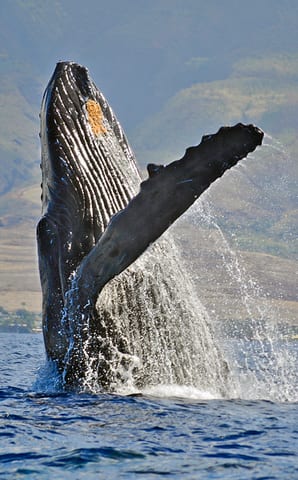 Federal regulations prohibit approaching humpback whales (by any means) within 100 yards (90 m) when on or in the water, and 1,000 feet (300 m) when operating an aircraft. These regulations apply to all ocean users, year-round throughout the Hawaiian Islands. Regulations are in place to protect humpback whales in the sanctuary and also apply anywhere within Hawaiian waters per the Endangered Species Act. Enforcement of these regulations are coordinated by the NOAA Office of Law Enforcement (OLE) with the U.S. Coast Guard (USCG), State of Hawaiʻi Department of Land and Natural Resources Division of Conservation and Resource Enforcement (DOCARE) and the NOAA Office of General Counsel.
Federal regulations prohibit approaching humpback whales (by any means) within 100 yards (90 m) when on or in the water, and 1,000 feet (300 m) when operating an aircraft. These regulations apply to all ocean users, year-round throughout the Hawaiian Islands. Regulations are in place to protect humpback whales in the sanctuary and also apply anywhere within Hawaiian waters per the Endangered Species Act. Enforcement of these regulations are coordinated by the NOAA Office of Law Enforcement (OLE) with the U.S. Coast Guard (USCG), State of Hawaiʻi Department of Land and Natural Resources Division of Conservation and Resource Enforcement (DOCARE) and the NOAA Office of General Counsel.
The following activities are prohibited within the sanctuary:
(a) The following activities are prohibited and thus unlawful for any person to conduct or cause to be conducted.
(1) Approaching, or causing a vessel or other object to approach, within the Sanctuary, by any means, within 100 yards of any humpback whale except as authorized under the Marine Mammal Protection Act, as amended (MMPA), 16 U.S.C. 1361 et seq., and the Endangered Species Act, as amended (ESA), 16 U.S.C. 1531 et seq.;
(2) Operating any aircraft above the Sanctuary within 1,000 feet of any humpback whale except as necessary for takeoff or landing from an airport or runway, or as authorized under the MMPA and the ESA;
(3) Taking any humpback whale in the Sanctuary except as authorized under the MMPA and the ESA;
(4) Possessing within the Sanctuary (regardless of where taken) any living or dead humpback whale or part thereof taken in violation of the MMPA or the ESA;
(5) Discharging or depositing any material or other matter in the Sanctuary; altering the seabed of the Sanctuary; or discharging or depositing any material or other matter outside the Sanctuary if the discharge or deposit subsequently enters and injures a humpback whale or humpback whale habitat, provided that such activity:
(i) Requires a Federal or State permit, license, lease, or other authorization; and
(ii) Is conducted:
(A) Without such permit, license, lease, or other authorization, or
(B) not in compliance with the terms or conditions of such permit, license, lease, or other authorization.
(6) Interfering with, obstructing, delaying or preventing an investigation, search, seizure or disposition of seized property in connection with enforcement of either of the Acts or any regulations issued under either of the Acts.
(b) The prohibitions in paragraphs (a)(1) through (a)(5) of this §922.184 do not apply to activities necessary to respond to emergencies threatening life, property or the environment; or to activities necessary for valid law enforcement purposes. However, while such activities are not subject to paragraphs (a)(1) through (a)(5) of this §922.184, this paragraph (b) does not exempt the activity from the underlying prohibition or restriction under other applicable laws and regulations (e.g., MMPA, ESA, and CWA).
(c) Any Sanctuary fishery regulations shall not take effect in Hawaii State waters until established by the State Board of Land and Natural Resources.
Molokini Snorkeling and Whale Watching
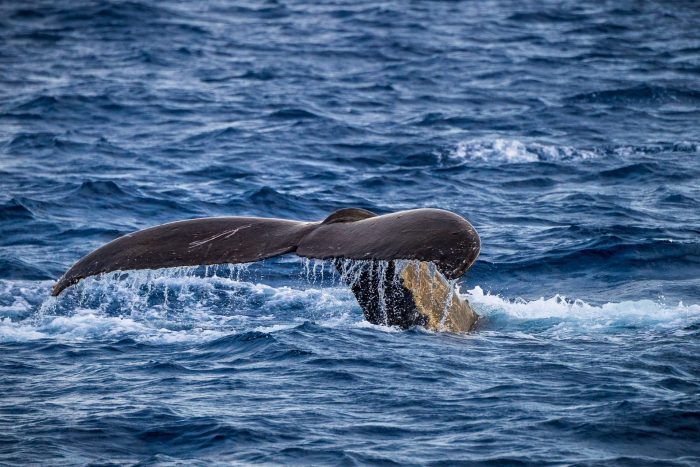 Snorkeling Molokini is an exciting and rewarding experience. Even if you are not an experienced swimmer, you can join in on the #1 Maui snorkel boat trip to Molokini! The Four Winds II is great for all ages and levels of swimmers. Guests can enjoy the glass-bottom viewing room and our super-fun water slide!
Snorkeling Molokini is an exciting and rewarding experience. Even if you are not an experienced swimmer, you can join in on the #1 Maui snorkel boat trip to Molokini! The Four Winds II is great for all ages and levels of swimmers. Guests can enjoy the glass-bottom viewing room and our super-fun water slide!
Molokini Crater is a popular destination for whale watching, snorkelers, scuba divers, and SNUBA diving. The crescent shape of Molokini crater protects swimmers and divers from waves and powerful currents. The winds are calmer in the morning and the trade winds tend to pick-up around the afternoon time. Molokini crater contains beautiful coral reefs and about 250 different species of fish. The visibility at the crater is excellent and can be up to 150 ft.
Molokini Crater is a protected Marine Life Conservation District and the island has been declared a Hawaii State Seabird Sanctuary. The crater is home to two species of nesting birds: Wedge-tailed Shearwaters and Bulwers Petrels. Shearwaters have a thin beak and feed on fish crustaceans. Bulwer’s Petrels spend most of their time at sea and are quite small yet have a long wingspan and are known for breeding on the north Pacific Islands (Hawaii and China).
Whale Watching is Dependent on Nature
It is impossible to guarantee the spotting of marine life in the wild, due to weather conditions and nature. Just like any wild animal, they have a mind of their own. Our captains try their best to search for whales during your Maui snorkel excursion. Some of our captains that have been working on our boats for over 30 years, and still, every whale season is like Christmas day.
Whale Songs
The humpbacks majestic whale songs are often heard while snorkeling in Maui. Both male and female humpback whales can produce sounds, however only the males produce the long, loud, complex “songs” for which the species is famous. These complex songs can be heard for miles and can last anywhere from 20 minutes to 24 hours!
What exactly is a whale song? A whale song is a pattern of predictable sounds that are created by whales. These predictable sound patterns actually resemble notes of a song. Music composers are in awe of the melodies that are created by these amazing animals.
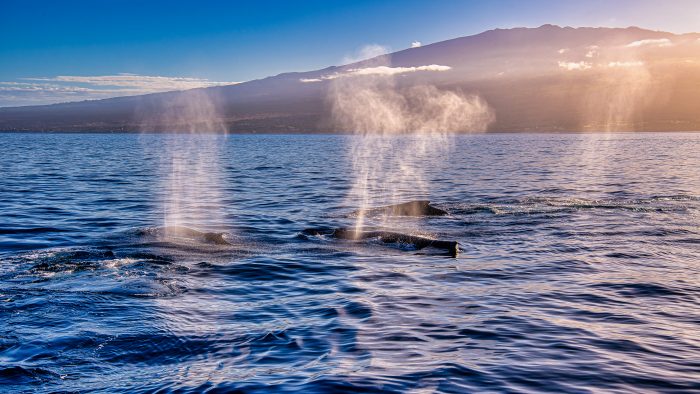
Of course, the actions the whales do above the water are exciting to see, but what does it sound like under the water? The Four Winds and the Maui Magic both have hydrophones, which are basically water proof microphones that we drop down in the water to about 10 feet. Each song consists of several sounds in a low register that vary in amplitude and frequency, and typically lasts from 10 to 20 minutes. Songs may be repeated continuously for several hours; humpback whales have been observed singing continuously for more than 24 hours at a time. These whales actually have no vocal cords, but generate their song by forcing air through their massive nasal cavities. Whales within a region sing the same song, for example, all of the humpback whales of the North Atlantic sing the same song, and those of the North Pacific sing a different song. Each population’s song changes slowly over a period of years, never returning to the same sequence of notes!
A Review From Our Guest Steve S. from January 2016
“Very well run tour. I was really impressed with the staff, they called me by name from the time I checked in until we got off the boat – – I wish I was that good at remembering names! Due to sea conditions beyond their control, we only got to snorkel at one location but it was beautiful! We also got to see awesome whale activity. In fact the tour would have been worth the money even without the snorkeling based on the whale watching. They dropped an underwater microphone into the water and let us listen to the whales for a few minutes, very cool! By the way, as an added bonus we had one of the best burgers i had all week, grilled on the boat for us at lunchtime. We found this tour to be an excellent value – – snorkeling, whale watching, and 2 meals (breakfast and lunch) all rolled into the cost.”
***The Four Winds II and the Maui Magic are proud to assist in conservation and protection of the coral reefs surrounding Maui, Hawaii. We strive to help educate everyone we take snorkeling. We encourage guests to use Reef Safe Sunscreen (also offered onboard all our vessels) and ask you to not touch marine life as it can be damaging to the fragile coral and ecosystem.
Some of the best whale watching in the world is located on our beautiful island of Maui. The waters surrounding Maui become a whales playground every winter (December through May). Thousands of humpback whales travel from the cold waters of Alaska down to the warm Hawaiian waters to breed, calve and nurse their young ones. Maui has a front seat in witnessing these magificient creatures, due to the shallow waters within the Auau Channel (located between Maui, Molokai and Lanai).
Many people come to Maui with a list of things they want to do during their vacation. Snorkeling Maui is an item at the top of many visitors lists. One of the great things about taking a Molokini snorkeling tour on the Four Winds II, is that you will be able to check more than one item off your list, all in one, or what we like to call, a “twofer”. Enjoy the best snorkeling in Maui and snorkel Molokini on a glass bottom boat. Experience some of the best whale watching on the way to your snorkel destination.
 History on Whaling and Hawaii
History on Whaling and Hawaii
Not only was Lahaina the capital of the Kingdom of Hawaii from 1820 to 1845, but it was also the center of whaling in Hawaii. In 1845, the capital moved to Honolulu. During 1820 to 1845, Lahaina was known as the the Pacifics top whaling port. Whaling ships (responsible for hunting the sperm whales for whalebone, but mainly for the oil from the whale blubber) anchored in Honolulu and Lahaina. The impact of whaling vessels within Hawaii shaped the Hawaiian economy and was the primary source of income for the islands until about 1854. Whalers were hunting thousands of whales each year and was headed towards extinction. Luckily today we have laws that protect the whales, which has helped increase the population in Hawaii.
Resource Protection of the Humpback Whales
 Federal regulations prohibit approaching humpback whales (by any means) within 100 yards (90 m) when on or in the water, and 1,000 feet (300 m) when operating an aircraft. These regulations apply to all ocean users, year-round throughout the Hawaiian Islands. Regulations are in place to protect humpback whales in the sanctuary and also apply anywhere within Hawaiian waters per the Endangered Species Act. Enforcement of these regulations are coordinated by the NOAA Office of Law Enforcement (OLE) with the U.S. Coast Guard (USCG), State of Hawaiʻi Department of Land and Natural Resources Division of Conservation and Resource Enforcement (DOCARE) and the NOAA Office of General Counsel.
Federal regulations prohibit approaching humpback whales (by any means) within 100 yards (90 m) when on or in the water, and 1,000 feet (300 m) when operating an aircraft. These regulations apply to all ocean users, year-round throughout the Hawaiian Islands. Regulations are in place to protect humpback whales in the sanctuary and also apply anywhere within Hawaiian waters per the Endangered Species Act. Enforcement of these regulations are coordinated by the NOAA Office of Law Enforcement (OLE) with the U.S. Coast Guard (USCG), State of Hawaiʻi Department of Land and Natural Resources Division of Conservation and Resource Enforcement (DOCARE) and the NOAA Office of General Counsel.
Activities Prohibited in the Sanctuary
(1) approaching, or causing a vessel or other object to approach, within the sanctuary, by any means, within 100 yards of any humpback whale except as authorized under the Marine Mammal Protection Act (MMPA), as amended, and the Endangered Species Act (ESA), as amended;
(2) operating any aircraft above the sanctuary within 1,000 feet of any humpback whale except when in any designated flight corridor for takeoff or landing from an airport or runway or as authorized under the MMPA and the ESA;
https://hawaiihumpbackwhale.noaa.gov/res/regulations.html
Whale Watching is Dependent on Nature
It is impossible to guarentee spotting of marine life in the wild, due to weather conditions and nature. Just like any wild animal, they have a mind of their own. Our captains do their best to try and find whales during your Maui Whale Watch tour excursion, and believe me, whale watching never gets old to them! We have captains that have been working on our boats for over 30 years, and still, every whale season is like Christmas day.
Whale Songs
What exactly is a whale song? A whale song is a pattern of predictable sounds that are created by whales. These predictable sound patterns actually resemble notes of a song. Music composers are in awe of the melodies that are created by these amazing animals.
Blue whales are also known for producing these melodies, but for humpback whales, these songs are only seen in the males during mating season. It is believed that the whale songs produced communicate the males youthfulness, health and are used to attract a mating partner.
